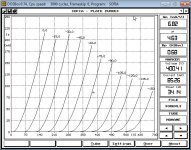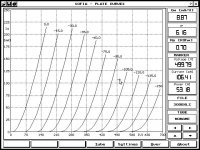I started my amp build as an Flesh and Blood clone despite several people warning me about the limitations (Pieter, Thomas, Jeff). After a long time tweaking it sounds better than my Audio Note quest but as was to be expected I am running into the 6SN7 cascade driver limitations. THD measurements are really good but IM distortion is to high which I think explains why orchestral work could sound better.
Pieter lent me a couple of 4P1L, 6J5 and C3g’s, did a quick test with a 6J5-4P1L cascade and it sounded better, a lot more dynamics, never heard Le Sacre sound better even on one speaker only, except live of course.
Could not get the C3g and 4P1L running ok in pentode before I had to leave for work, next few weeks I am away so I cannot continue my experiments.
I became quite charmed of the 4P1L and am reading a lot of positive reports on them so I am leaning towards a 4P1L-interstage-4P1L-interstage driver setup for the EML 300B-XLS. Simulations look good, you can find them attached to this post.
6J5 is less suitable for interstage coupling I think but choke or CCS loaded 6J5 to 4P1L would be another option but would require a coupling cap. and amplification factor is a bit high.
I am not ruling out the pentodes just yet.
By the way, I am using a inductive volume control and speakers are 104dB Avantgarde Uno horns.
The work points of attached circuit are chosen for their low IM distortion and low odd harmonics.
THD could be better with 40mA on the second 4P1L, lower H2 but higher H3 and IM which I think is not desirable.
It are only simulations which are no substitute for listening tests but it is the only thing I can do at the moment.
I probably also need to build a separate PS for the driver as the 500VDC for the 300B-XLS is a bit unpractical for a 4P1L IS driver. Was thinking about AZ1 CLCLC with two SSHV2’s a good opportunity to use those AZ1 tubes I have been hoarding.
So any comments, suggestions etc are most welcome.
Peter
Pieter lent me a couple of 4P1L, 6J5 and C3g’s, did a quick test with a 6J5-4P1L cascade and it sounded better, a lot more dynamics, never heard Le Sacre sound better even on one speaker only, except live of course.
Could not get the C3g and 4P1L running ok in pentode before I had to leave for work, next few weeks I am away so I cannot continue my experiments.
I became quite charmed of the 4P1L and am reading a lot of positive reports on them so I am leaning towards a 4P1L-interstage-4P1L-interstage driver setup for the EML 300B-XLS. Simulations look good, you can find them attached to this post.
6J5 is less suitable for interstage coupling I think but choke or CCS loaded 6J5 to 4P1L would be another option but would require a coupling cap. and amplification factor is a bit high.
I am not ruling out the pentodes just yet.
By the way, I am using a inductive volume control and speakers are 104dB Avantgarde Uno horns.
The work points of attached circuit are chosen for their low IM distortion and low odd harmonics.
THD could be better with 40mA on the second 4P1L, lower H2 but higher H3 and IM which I think is not desirable.
It are only simulations which are no substitute for listening tests but it is the only thing I can do at the moment.
I probably also need to build a separate PS for the driver as the 500VDC for the 300B-XLS is a bit unpractical for a 4P1L IS driver. Was thinking about AZ1 CLCLC with two SSHV2’s a good opportunity to use those AZ1 tubes I have been hoarding.
So any comments, suggestions etc are most welcome.
Peter
Attachments
-
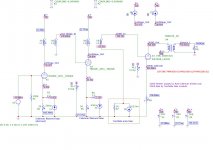 Circuit & FFT_Page_1.jpg131.1 KB · Views: 1,230
Circuit & FFT_Page_1.jpg131.1 KB · Views: 1,230 -
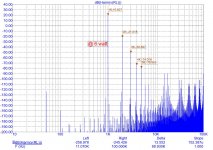 Circuit & FFT_Page_2.jpg259.3 KB · Views: 1,207
Circuit & FFT_Page_2.jpg259.3 KB · Views: 1,207 -
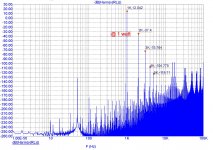 Circuit & FFT_Page_3.jpg455.5 KB · Views: 1,080
Circuit & FFT_Page_3.jpg455.5 KB · Views: 1,080 -
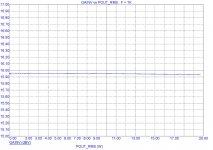 Distortion_Gain v POUT.jpg293.3 KB · Views: 126
Distortion_Gain v POUT.jpg293.3 KB · Views: 126 -
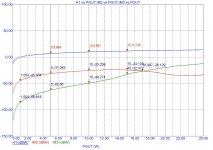 Distortion_IM.jpg275.4 KB · Views: 147
Distortion_IM.jpg275.4 KB · Views: 147 -
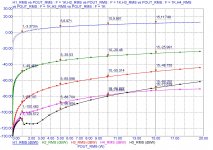 Distortion_H v POUT.jpg347.2 KB · Views: 995
Distortion_H v POUT.jpg347.2 KB · Views: 995 -
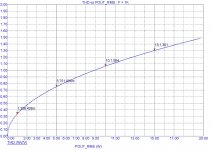 Distortion_THD v POUT.jpg297.8 KB · Views: 1,014
Distortion_THD v POUT.jpg297.8 KB · Views: 1,014 -
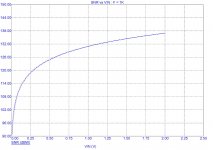 Distortion_SNR.jpg201 KB · Views: 150
Distortion_SNR.jpg201 KB · Views: 150
Hi!
The 6J5 can be easily transformer coupled. I used it successfully with Lundahl LL1660 gapped for 7.5mA or 10mA. Also works well with Tango NC20 or NC16.
There are other suitable ITs too.
Thomas
6J5 is less suitable for interstage coupling I think
The 6J5 can be easily transformer coupled. I used it successfully with Lundahl LL1660 gapped for 7.5mA or 10mA. Also works well with Tango NC20 or NC16.
There are other suitable ITs too.
Thomas
Hi Thomas
Thanks, good to know, I thought that the higher Rp of 7700 ohm would make it borderline in its usability with interstages and my first attempts simulating it where not as good as with two 4P1L's. Besides you can't use filament bias so would need a cathode resistor bypass cap.
Is it best to use the exact current for the interstage or can you also use a higher current interstage? Asking because I was thinking that a 40mA interstage (between 4P1L & 300B) would give me the opportunity to experiment more.
Peter
Hi!
The 6J5 can be easily transformer coupled. I used it successfully with Lundahl LL1660 gapped for 7.5mA or 10mA. Also works well with Tango NC20 or NC16.
Thanks, good to know, I thought that the higher Rp of 7700 ohm would make it borderline in its usability with interstages and my first attempts simulating it where not as good as with two 4P1L's. Besides you can't use filament bias so would need a cathode resistor bypass cap.
Is it best to use the exact current for the interstage or can you also use a higher current interstage? Asking because I was thinking that a 40mA interstage (between 4P1L & 300B) would give me the opportunity to experiment more.
Peter
Hi!
Then use ultra path, just as good
A higher current interstage will have less primary inductance. Especially with higher rp tubes you will need higher primary inductance so it is important to select the right interstage.
Thomas
Besides you can't use filament bias so would need a cathode resistor bypass cap.
Then use ultra path, just as good
Is it best to use the exact current for the interstage or can you also use a higher current interstage? Asking because I was thinking that a 40mA interstage (between 4P1L & 300B) would give me the opportunity to experiment more.
A higher current interstage will have less primary inductance. Especially with higher rp tubes you will need higher primary inductance so it is important to select the right interstage.
Thomas
Hi
Yes good idea, the value of this cap influences the low frequency roll-off if I am not mistaken.
Ok clear.
Simulation shows almost similar distortion patterns for 4P1L and 6J5 interstage coupled.
The 300B-XLS with a 5k OPT can deliver about 17-18 watt which would require 250Vpp at the grid.
With the 4P1L-IS-4P1L-IS 18W would require 3.85Vpp at the input, driver clipping starts at 5.6Vpp (1.98Vrms)
With the 6J5-LL1660-4P1L-IS 18W would require 1.64Vpp at the input, driver clipping starts at 2.2Vpp (778mVrms)
Seems to me that 4P1L as first tube would be a better idea, less gain and a interstage with less inductance can be used due to lower Rp of 2400 ohm.
Peter
Then use ultra path, just as good
Yes good idea, the value of this cap influences the low frequency roll-off if I am not mistaken.
A higher current interstage will have less primary inductance. Especially with higher rp tubes you will need higher primary inductance so it is important to select the right interstage.
Ok clear.
Simulation shows almost similar distortion patterns for 4P1L and 6J5 interstage coupled.
The 300B-XLS with a 5k OPT can deliver about 17-18 watt which would require 250Vpp at the grid.
With the 4P1L-IS-4P1L-IS 18W would require 3.85Vpp at the input, driver clipping starts at 5.6Vpp (1.98Vrms)
With the 6J5-LL1660-4P1L-IS 18W would require 1.64Vpp at the input, driver clipping starts at 2.2Vpp (778mVrms)
Seems to me that 4P1L as first tube would be a better idea, less gain and a interstage with less inductance can be used due to lower Rp of 2400 ohm.
Peter
Just beware of the microphonics as an input tube. Output, not a big problem.
I gave up on the 4P1L as an input tube.
Thanks for the heads up. I had read about microphonics problem of the 4P1L as input tube. Noticed it myself when I tested it in 6J5-4P1L configuration, as 2nd tube it seemed manageable. As input tube it will be a problem especially since the monoblocks are situated next to the speakers.
Bias with 500V and 106mA is a bit high for 300B XLS. So you can hear more rigid, dry sound than standard 300B. Not much OPT in the market can run over 100mA without some saturation.
I take bias for my KR 300B XLS about Vak 400V/ 80-90mA for getting long life and musicality.
I run C3g in triode (G2,3 connect to anode) driving to mesh plate 300B , Sound is fantastic.
I take bias for my KR 300B XLS about Vak 400V/ 80-90mA for getting long life and musicality.
I run C3g in triode (G2,3 connect to anode) driving to mesh plate 300B , Sound is fantastic.
I have some interstages wich would be perfect for such a load.
It's designed for a tube with Ri=7700Ω and 10mA current. Frequency response 8Hz-140KHz (-3dB)
It's designed for a tube with Ri=7700Ω and 10mA current. Frequency response 8Hz-140KHz (-3dB)
Hi Thomas
Thanks, good to know, I thought that the higher Rp of 7700 ohm would make it borderline in its usability with interstages and my first attempts simulating it where not as good as with two 4P1L's. Besides you can't use filament bias so would need a cathode resistor bypass cap.
Is it best to use the exact current for the interstage or can you also use a higher current interstage? Asking because I was thinking that a 40mA interstage (between 4P1L & 300B) would give me the opportunity to experiment more.
Peter
Bias with 500V and 106mA is a bit high for 300B XLS. So you can hear more rigid, dry sound than standard 300B. Not much OPT in the market can run over 100mA without some saturation.
I take bias for my KR 300B XLS about Vak 400V/ 80-90mA for getting long life and musicality.
I run C3g in triode (G2,3 connect to anode) driving to mesh plate 300B , Sound is fantastic.
I don't think that 500V@106mA is to high for the EML 300B-XLS. Works well for me with a 5K OPT which is a custom made Tribute, low frequency saturation start was below 20Hz if I remember correctly.
I attached screenshots of the Sofia plots for the XLS at 400V and 500V.
Did a quick test with the C3g in triode but I like the 4P1L better as driver for the 300B but nothing decided yet.
Attachments
I have some interstages wich would be perfect for such a load.
It's designed for a tube with Ri=7700Ω and 10mA current. Frequency response 8Hz-140KHz (-3dB)
I will keep that in mind. Currently inclined to go with a 26-IS-4P1L-IS combination.
The 26 @ 5.4mA and the 4P1L @ 28mA
I have another interstage too: 2300Ω /25mA
Just sold some others otherwise i could offer more.
Just sold some others otherwise i could offer more.
I will keep that in mind. Currently inclined to go with a 26-IS-4P1L-IS combination.
The 26 @ 5.4mA and the 4P1L @ 28mA
I don't think that 500V@106mA is to high for the EML 300B-XLS. Works well for me with a 5K OPT which is a custom made Tribute, low frequency saturation start was below 20Hz if I remember correctly.
I attached screenshots of the Sofia plots for the XLS at 400V and 500V.
Did a quick test with the C3g in triode but I like the 4P1L better as driver for the 300B but nothing decided yet.
You can try both operation points and get one you like
Some notes on C3g in triode: g2 & 3 connet to anode, coupling by Interstage tranny, bias at 180V 18-20mA. I receive many compliments to my power amp with C3g-IT-300B from friends in our tube DIY club.
Which interstage transformer you are using for C3g?You can try both operation points and get one you like. my taste is 400V 80-90mA.
Some notes on C3g in triode: g2 & 3 connet to anode, coupling by Interstage tranny, bias at 180V 18-20mA. I receive many compliments to my power amp with C3g-IT-300B from friends in our tube DIY club.
I will keep that in mind. Currently inclined to go with a 26-IS-4P1L-IS combination.
The 26 @ 5.4mA and the 4P1L @ 28mA
That's what I use. And you can use both in filament bias with Rod Coleman regulators, so no cathode bypasses which I consider important. I use the LL1660/5mA for the 26 and the Hammond 126C for the 4P1L which sounds very good and is very good value. I use the 4P1L at 15mA as a result.
What I found is that PSE 4P1L in filament bias sounded better than 300b with resistor and cathode bypass cap. So replaced the 300bs in two amps I have, and that's my daily amp. Once you've built it, it's a lot cheaper to run!!
Which interstage transformer you are using for C3g?
here is my amp
http://www.diyaudio.com/forums/tubes-valves/217887-recommended-300b-se-amplifier-designs-3.html
What I found is that PSE 4P1L in filament bias sounded better than 300b with resistor and cathode bypass cap. So replaced the 300bs in two amps I have, and that's my daily amp. Once you've built it, it's a lot cheaper to run!!
I have enough parts for building 4P1L SE amp, but no time to do it. Will build it soon with fixed bias 4P1L. Many friends made this amp with auto bias for 4P1L and the results are not special.
I don't think 4P1L having better sound quality than 300B. Their sound are different cause of not same bias, OPT and parts (for bias)...
Rk and Ck for 300B are concerned the sound quality very much. They can degenerate sound if using cheap/ not good parts.
Last edited:
What´s the bennefit of having both g to anode,instead of one g to the cathod?Some notes on C3g in triode: g2 & 3 connet to anode,
I have enough parts for building 4P1L SE amp, but no time to do it. Will build it soon with fixed bias 4P1L. Many friends made this amp with auto bias for 4P1L and the results are not special.
I don't think 4P1L having better sound quality than 300B. Their sound are different cause of not same bias, OPT and parts (for bias)...
Rk and Ck for 300B are concerned the sound quality very much. They can degenerate sound if using cheap/ not good parts.
I'm ONLY talking about the 4P1L in PSE filament bias. This doesn't apply to the 4P1L in auto bias with cathode bypass or even in fixed bias. It is the filament bias that matters. That's the whole point - you can't use the 300b or indeed the 2a3 in filament bias so you are stuck with fixed bias or auto bias with cathode bypass. They may be intrinsically better tubes, but it's all a question of how you use them in the circuit. 4P1L is one of the few tubes that can be sensibly used in filament bias as an output. Another is the 10Y - a lot greedier on the supply, however, so possible but not sensible.
Last edited:
- Status
- This old topic is closed. If you want to reopen this topic, contact a moderator using the "Report Post" button.
- Home
- Amplifiers
- Tubes / Valves
- Driver options for 300B-XLS (4P1L-IS-4P1L-IS)
